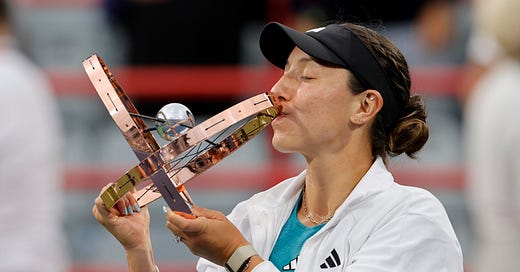Pegula vs Samsonova: Montreal Final Analysis (WTA 1000)
Jessica Pegula played a perfect match to expand her winning prowess to Canada, after USA and Mexico.
Jessica Pegula followed up her second win of the 2023 season over world #1 Iga Swiatek with a flawless match against Liudmila Samsonova to capture her third career WTA Tour title.
In a final that lasted only 49 minutes, Pegula was perfect behind her 1st serve, going 19-for-19 (100%). She backed it up with a high-level performance against Samsonova's serve, winning 50% of 1st serve return points (10/20) and 76% of 2nd serve return points (13/17).
Utter dominance that resulted from Pegula’s minimal-error formula:
2 double faults + 2 groundstroke unforced errors over 2 sets = 2nd WTA 1000 title
It was short work, but a very impressive one!
The meaningful numbers for Samsonova resembled more a “3, 2, 1” countdown. Ongoing rain in Montreal forced the postponement of the second semi-final to sunday. It meant Samsonova had just a 2-hour rest between her 3-set win over 3rd-seed Elena Rybakina and the start of the final. It didn’t work out well as the 24-year old never found her rhythm and ended up winning just 1 game.

The Montreal final was very one-sided, so it was no surprise that Pegula topped almost every metric.
True to her credentials as one of the best returners in the world, Pegula hit 3 return winners and another 4 returns that forced errors, for a total of 7 winning returns. An output that was very close to neutralizing Pegula’s 8 return errors. By contrast, Samsonova missed 9 returns but she barely minimized that with a single winning return.
Return Performance
J. Pegula
7 winning returns (3 winners + 4 forcing)
8 errors (8 forced errors)
L. Samsonova
1 winning return (1 forcing)
9 errors (4 unforced errors + 5 forced errors)
Points didn’t get any better for Samsonova when rallies developed. The WTA 1000 debutant finalist only managed to win 11 of 39 (28%) rallies, in consequence of Pegula’s incredible performance from the back of the court. The American put up jaw-dropping numbers, winning 73% (27/37) of baseline points.
Samsonova struggled from the back (29% of baseline points won) but she did even worse in her rare forward moves, going 1-for-4 (25%) net points.
Where did it all go wrong for Samsonova from the back of the court? It was actually both wings that underperformed.
Pegula used the forehand for offense, striking 10 winners (twice more than Samsonova) while making 5 fewer errors (9 vs 14).
Offensive production from the backhand side was meager, with each player hitting 1 backhand winner. However, Pegula’s backhand was rock-solid, accumulating only 4 errors, none of which unforced. On the other side of the net, Samsonova made 15 backhand errors, including 7 unforced errors.
Forehand Performance
Pegula: 10 winners / 9 errors = +1
Samsonova: 5 winners / 14 errors = -9
Backhand Performance
Pegula: 1 winner / 4 errors = -3
Samsonova: 1 winner / 15 errors = -14

Pegula did a magnificent job in all rally length categories:
Doubled-up in short rallies, for a 20-point advantage;
Won 9 of 11 (82%) medium rallies;
Prevailed in all 3 long rallies played.
In Montreal, Jessica Pegula experienced one of the best weeks of her professional career:
got over the Canadian semifinal hurdle (Pegula had lost in the semifinals in her only two previous appearances);
defeated doubles partner Coco Gauff and the top-ranked Iga Swiatek in tight 3-setters, in consecutive matches, to reach the final;
was untouchable in the final to conquer a 3rd career title, 2nd at WTA 1000 level.
After wins in Washington (2019) and Guadalajara (2022), Pegula showed once again she delivers her best tennis in Central and North America.
Jessica Pegula (WTA #4, seed 4) vs Liudmila Samsonova (WTA #18, seed 15)
WTA 1000 Montreal Final - Match Data
Set by Set Stats

Serve & Return
1st Serves
2nd serves
Rallying
Rallying performance “maps”
Rally Length
Points won breakdown
This final section intends to give a last, broader look at the match by presenting how each player won points. Points are listed according to their frequency (highest to lowest) and are named in relation to the last touch on the ball. For simplicity, groundstrokes hit from the 5th shot onwards are grouped together.
Breakdown by side (FHs or BHs)

Breakdown by error type (UFEs or FEs)

To find out more about the stats published here, please visit the following post.
Thumbnail photo credit: official Jessica Pegula Twitter.













